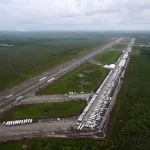
Floodwaters forced people out of their homes in parts of Iowa, the result of weeks of rain, while much of the United States longed for relief Saturday from yet another round of extraordinary heat.
Sirens blared at 2 a.m. in Rock Valley, Iowa, population 4,200, where people in hundreds of homes were told to get out as the Rock River could no longer take rain that has slammed the region.
The city lacked running water because wells were unusable.
Mayor Kevin Van Otterloo said a state helicopter was on its way to help but was called off when boats were able to reach stranded residents.
“We’ve had so much rain here,” he said. “We had four inches last night in an hour and a half time. Our ground just cannot take anymore.”
Gov. Kim Reynolds declared a disaster for Sioux County, which includes Rock Valley.
Drone video posted by the local sheriff showed no streets, just roofs and the tops of trees above water.
Elsewhere in the U.S., the miserable grip of heat and humidity continued.
Have you ever been in a flood?
Yes: 44% (288 Votes)
No: 56% (367 Votes)
The National Weather Service said roughly 15 million people were under a heat warning — the highest warning — while another 90 million were under a heat advisory.
Millions of residents across the country have had their lives disrupted by days of unusually high temperatures.
The U.S. last year experienced the most heat waves since 1936, experts said.
An Associated Press analysis of Centers for Disease Control and Prevention data found that the excessive heat contributed to more than 2,300 U.S. deaths, the highest number in 45 years of records.
Temperatures around 100 degrees Fahrenheit were predicted for Washington, D.C., and Richmond, Virginia, while Philadelphia; Newark, New Jersey; Columbus, Ohio; and Detroit were bracing for the high 90s.
Heat-related hospital visits in New York state lately were 500% higher than on the average June day, according to the Department of Health.
“We still have this prolonged heat wave across portions of the Ohio Valley and into the Northeast,” weather service meteorologist Marc Chenard said. “We get a little bit of relief by early in the week, at least in the eastern U.S., the Northeast, but in general above-normal temperatures are going to cover a large portion of the country even into next week.”
In southeastern Michigan, DTE Energy said 8,300 customers still lacked power Saturday morning from storm-related outages, compared to 75,000 homes and businesses earlier in the week.
Flooding from rain was a problem in southeastern South Dakota and northwestern Iowa.
Several highways were closed, including a key stretch of Interstate 29, south of Sioux Falls, where there were no alternate routes.
Sioux Falls, South Dakota’s largest city, had more than 7 inches (17.7 centimeters) of rain in three days.
In Iowa, power was cut off at wastewater treatment plants in Hawarden and Spencer, which together have 14,000 residents.
Aiden Engelkes said he and his girlfriend grabbed clothes, cats and bottled water and left their flooded first-floor apartment in Spencer for a friend’s dry space on the fourth floor.
“It’s terrifying,” Engelkes, 20, said, adding that friends across the street were on a roof waiting for help.
In New Mexico, heavy rain and flash flood warnings prompted officials to order some mandatory evacuations, with shelters set up for displaced residents.
The National Weather Service office announced a flash flood emergency on Friday night through early Saturday. The impacted areas included the city of Las Vegas, New Mexico and communities near Albuquerque.
In Ruidoso, a mountain village in New Mexico, full-time residents will be allowed to return Monday after they were forced out by wildfires, though everyday life won’t return to normal.
“You’re going to need to bring a week’s worth of food, you’re going to need to bring drinking water,” Mayor Lynn Crawford said on Facebook.
The Western Journal has reviewed this Associated Press story and may have altered it prior to publication to ensure that it meets our editorial standards.







